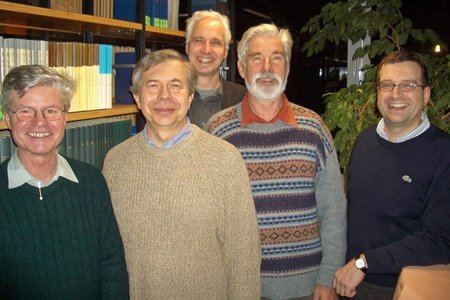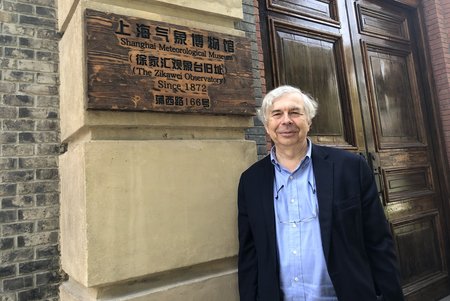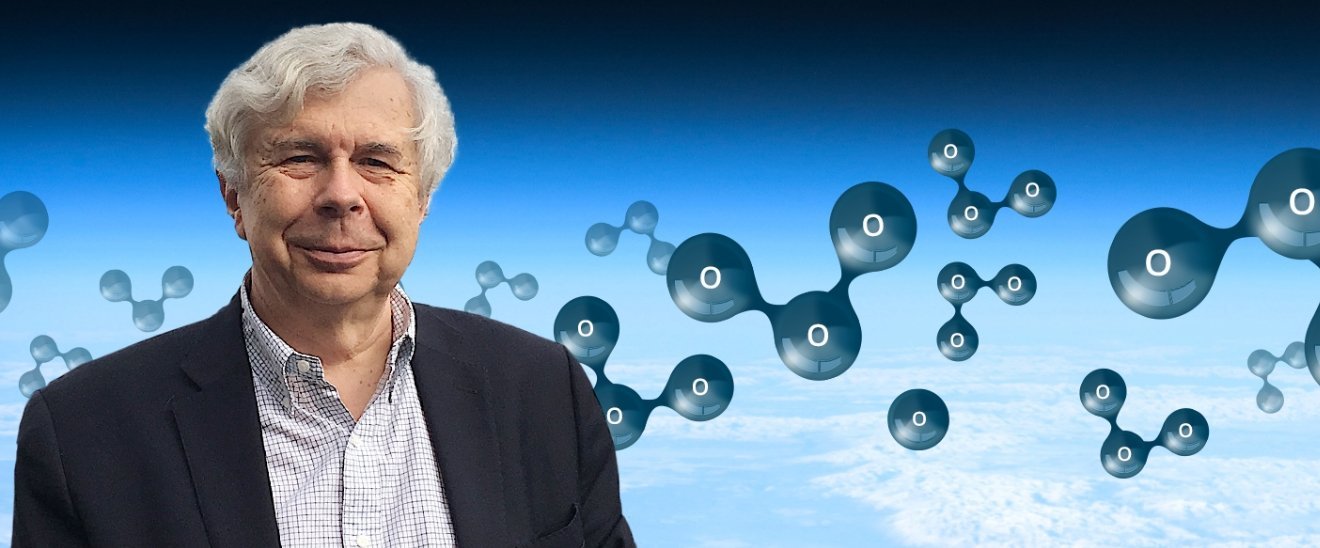Ozone, air chemistry, Earth-system science, environmental modeling — researcher portrait Guy Brasseur
School and studies in Belgium
Guy Brasseur´s interest in atmospheric science and his passion for writing down findings and correlations in books began at school, where he was very interested in meteorology and operated a weather station that his school had purchased. This was to teach and learn how to make measurements as part of physics lessons. At the age of 15, Guy Brasseur wrote his first book about his findings on meteorology, but it was not published at first. While studying applied physics and telecommunications at the Free University of Brussels, he submitted this book to a competition on the advice of his mentor and won the Scientific Prize for Young Scientists in 1973, which was offered by the pharmaceutical company Glaxo and presented to him in the presence of the Belgian Minister of Research. This meant that his first book was already successful, and several more were to follow.
In Brussels, Guy Brasseur was not able to study meteorology as a subject, but he wanted to at least write the master thesis of his physics degree on a topic related to the atmosphere. He ended up writing a thesis on the atmosphere of Venus under the supervision of Prof. Marcel Nicolet, who was the Director of the Belgian Institute for Space Aeronomy. After graduation, Prof. Nicolet encouraged him to also write a PhD thesis, although Guy Brasseur did not initially intend to do so. As part of his doctoral thesis, he turned to air chemistry and research on the ozone layer, a highly debated topic in the scientific community at that time.
A new field of research develops
At the beginning of the 1970s, the scientific community raised a question: Are the emissions by a fleet of supersonic aircraft that are supposed to be in operation in the following years likely to destroy the ozone layer that protects the Earth´s biosphere from the harmful effect of solar ultraviolet (UV) radiation? Already in the 1960s, it had been indicated that the water vapor emitted by the engines of these supersonic aircraft would alter the ozone layer and hence increase the incidence of skin cancer in humans. In 1971, Harold Johnston showed that the danger came less from water vapor than from nitrogen oxides, and that the projected increase in stratospheric oxides of nitrogen could reduce the ozone shield by about a factor 2. A year earlier, Paul Crutzen had shown that the most important natural process responsible for the destruction of ozone in the stratosphere is a catalytic cycle involving nitrogen oxides, even if these were only present in very small quantities in this layer of the atmosphere. At that time, nitrogen oxides had never been detected in the stratosphere and the fundamental understanding of photochemical processes in the stratosphere was still very limited. A new field of research was to be developed (Brasseur, 2020b). Guy Brasseur therefore wanted to write his dissertation on a topic in this field. He contacted Marcel Nicolet, who suggested to develop and use a mathematical model to estimate the impact of a hypothetical fleet of supersonic aircraft on stratospheric ozone.
After his doctorate, Guy Brasseur obtained a position at the Belgian Institute for Space Aeronomy. In addition to his scientific interests, Guy Brasseur was also involved in Belgian politics for a time. Already as a student, he was a member of the city council of Uccle, a municipality in southern Brussels, where he also lived. Between 1977 and 1981, he was an elected member of the Belgian Chamber of Deputies and a delegate to the parliamentary assemblies of the Council of Europe in Strasbourg and the Western European Union in Paris. Research was officially held in abeyance as he was on leave for his political activities, but he continued to supervise his doctoral students; sometimes papers were corrected in less exciting parliamentary sessions.
MPI for Chemistry and NCAR: Ozone and Earth-system research
His time in politics came to an end with new elections, and back in science came the desire to go to the United States for a year. Before that, however, Guy Brasseur spent five months at the Max Planck Institute for Chemistry (MPI-C) in 1984, where he worked with Prof. Paul Crutzen, whose research he had already encountered when he was doing his PhD. Paul Crutzen received the Nobel Prize in Chemistry in 1995, together with Mario J. Molina and F. Sherwood Rowland, for explaining how nitrogen oxides destroy the ozone layer and the chemical processes that create the ozone hole. Prof. Crutzen recently passed away on January 21, 2021. Guy Brasseur: “Paul was an extraordinary person. He continuously brought up new concepts that became the source of new research developments and had a major influence on the research agenda and on international ozone and climate policy.”
The stay in Mainz at the MPI-C was followed by a year as a guest at the National Center for Atmospheric Research (NCAR) in Boulder, Colorado, USA. Initially, Guy Brasseur did not accept a job offer from NCAR because he did not want to give up his permanent position in Belgium. However, after returning to Belgium and some time to think about it, he took a leave of absence for two more years to work at NCAR and then stayed there. Two years later, in 1990, Guy Brasseur became Director of the Atmospheric Chemistry Division at NCAR. At that time, the scientific community was actively interested in the problem of tropospheric ozone. Measurements made in different regions of the world had highlighted a significant increase in the ozone concentration, not only at the surface in urban areas such as in Los Angeles during summer, but also in the remote free atmosphere. As the presence of ozone, a powerful oxidant that irritates the respiratory system, can increase the frequency of asthma attacks and cause chronic pulmonary obstructions, it was important to understand the chemical processes that lead to its photochemical formation and destruction. Therefore, tropospheric ozone became a major research topic for the NCAR division, and global change research had become a priority in this department (Brasseur, 2020b).
The question of global air pollution was immediately perceived as essential and the United States, in particular the National Science Foundation (NSF), defined a vast research program under the name of “Global Tropospheric Chemistry Program (GTCP)”. An international extension, the “International Global Atmospheric Chemistry (IGAC) Project”, was quickly established and linked to the “International Geosphere-Biosphere Program (IGBP)”. Guy Brasseur chaired the Steering Committee of the IGBP between 2002 and 2005 and worked closely together with the IGBP Director Will Steffen. Together, they promoted the concept of “Earth System Science” and the need for global and regional climate models to become more integrative and include coupled chemical and biological processes as well as their interactions with the human system. During this time at NCAR, Guy Brasseur with colleagues and software engineers developed a global chemical transport model focusing on the problem of tropospheric ozone (Brasseur et al., 1998). This model, called MOZART (Model for Ozone and Related Tracers) was soon adopted by several groups around the world (Brasseur, 2020b).
Director at MPI-M: Laying the foundation for ICON

After a little more than 10 years at NCAR, Guy Brasseur was interested in new tasks. There were several offers from all over the world. In the end, the Max Planck Society was successful with its call to bring Guy Brasseur to Hamburg as Director at MPI-M. By the early 2000s, the scientific community recognized the importance of the complex nonlinear interactions and feedbacks in the multi-scale evolution of the climate system. Therefore, he dedicated himself at MPI-M to the task of extending traditional climate models to more comprehensive Earth-system models that couple the biogeochemical system to the physical climate system and account in particular for atmospheric chemistry and the marine biogeochemical processes (Brasseur, 2020b).
Under the leadership of Guy Brasseur, in addition to some restructuring at MPI-M and the introduction of the concept of Earth-system research and Earth system modeling, there were also initial ideas for a completely new Earth-system model: ICON (Icosahedral Non-Hydrostatic). The dynamical core of the sophisticated MPI Earth-system model ECHAM-MPIOM appeared to be outdated, and the first step was to see if it might be useful to develop a novel model with a new dynamical core. A small group of scientists was tasked with assessing this. It soon appeared that the development of new atmosphere and ocean models with dynamical cores and the capability of zooming in different regions of the world with extremely high spatial resolution would offer new opportunities: treating global and regional climate change in a single mathematical framework, addressing multi-scale dynamical questions and improving weather forecasting. Since Guy Brasseur left MPI-M in early 2006, he witnessed the positive development of the new ICON model only from a distance. ICON is now a pioneer in modern Earth-system model development and is praised as very innovative by the American NSF, for example.
Climate Service Center Hamburg: Climate services for decision makers
Guy Brasseur´s path led him back to NCAR in January 2006 as Associate Director and Head of the Earth and Sun Systems Laboratory, where he remained until July 2009. After his return from the USA, he implemented the idea he had already developed during his time at MPI-M to install a so-called Earth System Service as founding director of the “Climate Service Center Germany” (now GERICS, then CSC). With a small group of high-ranking researchers, he had submitted an idea sketch to the German Federal Ministry of Education and Research (BMBF) during his MPI-M time. But it was not until 2010 that the German “Climate Service Center” was established in Hamburg with funding from the BMBF. The purpose of it is to provide scientifically credible and actionable climate information to decision makers. The task was fascinating, but the same time not easy for Guy Brasseur, because it required an appropriate two-way interaction with users. However, it offered a unique opportunity to develop a transdisciplinary vision with the participation of natural and social scientists as well as representatives from industry, government and municipalities. In Guy Brasseur´s view, a lot of fundamental research questions remain to be answered, in particular about the type of business model required to make climate services successful and about new approaches to communication and partnerships with different types of actors in society (Brasseur & Gallardo, 2016; Brasseur, 2020b).
Environmental Modeling Group: Improving prediction of regional air quality

After handing over the leadership of GERICS to former MPI-M scientist Daniela Jacob, Guy Brasseur found his scientific home again at MPI-M, where he leads the group “Environmental Modeling”. The group develops integrated modeling approaches that address societally important environmental questions associated with human development. This involves issues raised by climate change, population growth, urbanization, industrialization, and intensive agricultural practices. An important priority is to assess the impact of urbanization on the regional and global environment.
One task is to improve the ability to predict regional air pollution, especially in Asia (China), South America (Brazil) and Africa. The development of comprehensive tools for the analysis and prediction of air quality can help decision makers to take science-informed action to reduce chemical emissions, specifically in industrialized and urbanized regions. The group contributes to the development of such integrated modeling systems that base their predictions on assimilated satellite observations, updated emission inventories, chemical and microphysical transformations, multi-scale transport processes, and surface deposition.
For example, due to the strong economic growth in China in the past decade, air pollution has become a serious issue in many parts of the country. For this reason, up-to-date regional air pollution information and means for emission control of main pollutants are becoming more and more important. Within the EU FP7 program, there have been two collaborative research projects in which Chinese and European partners cooperate to study air quality in China by using space observations. In one of these two projects, PANDA, the Environmental Modeling group is involved as coordinator.
Is fundamental research still important? Personal considerations by Guy Brasseur
Looking back, in the last decade, funding agencies in most countries have increasingly emphasized the importance of applied research to address important societal problems, sometimes at the expense of fundamental research. Clearly, the role of scientists is to work with different stakeholders to tackle societally important questions and to respond to urgent challenges such as ozone depletion or climate change. At the same time, there will be no sustained applied science without an upstream input of knowledge provided by fundamental research. Today, there is an urgent need to support long-term research initiatives and maintain a strong intellectual capacity able to respond to surprises facing our planet. Perhaps the scientific community should show more convincingly how unselfish research is a prerequisite for the development of innovation and is therefore essential for our economic, social, and cultural development (Brasseur, 2020b).
Research on the ozone problem is an example of how science has evolved for almost two centuries and has addressed a problem of highest importance to the future of humanity (Brasseur, 2020a). The discovery in the laboratory of a peculiar odor produced by the formation of an unknown chemical species, which was not identified until more than 20 years later, did not result from a planned research initiative. The progress which followed was the work of a few independent scholars who communicated with each other, and who presented their results in journals published by their national academies. Not all the ideas put forward were immediately accepted; some were dismissed after much discussion and debates between colleagues. However, all of these pioneers in ozone research were free thinkers and motivated minds who displayed great intellectual independence and selflessness. None of them probably, while they were conducting their research, suspected that the stratospheric ozone question would one day become a quasi-political issue (Brasseur, 2020b).
Guy Brasseur: “Solutions to current problems cannot be found without further fundamental research. An institution like the Max Planck Society stands exemplary for the freedom of fundamental research. Free research on completely new topics generates new knowledge that can contribute to solving problems that are perhaps still unknown today. As Max Planck said: 'Insight must precede application.'”
Books
- Brasseur, G. P., & Solomon, S. (2005). Aeronomy of the middle atmosphere (p. 644). Dordrecht, The Netherlands: Springer.
- Brasseur, G. P., & Jacob, D. J. (2017). Modeling of atmospheric chemistry (p. 606). Cambridge, UK: Cambridge University Press.
- Brasseur, G. (2020a). The ozone layer, from discovery to recovery (pp. 264). Boston, MA: American Meteorological Society.
Publications
Brasseur, G., & Nicolet, M. (1973). Chemospheric processes of nitric oxide in the mesosphere and stratosphere. Planetary and Space Science, 21(6), 939–961. https://doi.org/10.1016/0032‐0633(73)90141‐4
Brasseur, G. (1984). Coupling between the thermosphere and the stratosphere: The role of nitric oxide. In J. Taubenheim (Ed.), Handbook for MAP (Vol. 10, pp. 116–121). Urbana, IL: Scientific Committee on Solar‐Terrestrial Physics (SCOSTEP), University of Illinois.
Brasseur, G. P., & Granier, C. (1992). Mount Pinatubo aerosols, chlorofluorocarbons, and ozone depletion. Science, 257(5074), 1239–1242. https://doi.org/10.1126/science.257.5074.1239
Brasseur, G. P., Hauglustaine, D. A., Walters, S., Rasch, P. J., Müller, J.‐F., Granier, C., & Tie, X. X. (1998). MOZART, a global chemical transport model for ozone and related tracers: 1. Model description. Journal of Geophysical Research, 103(D21), 28,265–28,289. https://doi.org/10.1029/98JD02397
Brasseur, G., & Gallardo, L. (2016). Climate services: Lessons learned and future prospects. Earth's Future, 4(3), 79–89. https://doi.org/10.1002/2015EF000338
Brasseur, G. P., Xie, Y., Petersen, K., Bouarar, I., Flemming, J., Gauss, M., et al. (2019). Ensemble forecasts of air quality in eastern China—Part 1: Model description and implementation of the MarcoPolo‐panda prediction system, version 1. Geoscientific Model Development, 12(1), 33–67. https://doi.org/10.5194/gmd‐12‐33‐2019
Brasseur, G.P. (2020b) The importance of fundamental science for society: The success story of ozone research. Perspectives of Earth and Space Scientists. AGU, https://doi.org/10.1029/2020CN000136.
Contact
Prof. Dr. Guy Brasseur
Max Planck Institute for Meteorology
Phone: 040 41173 301 (assistant Ina Döge)
Email: guy.brasseur@mpimet.mpg.de

